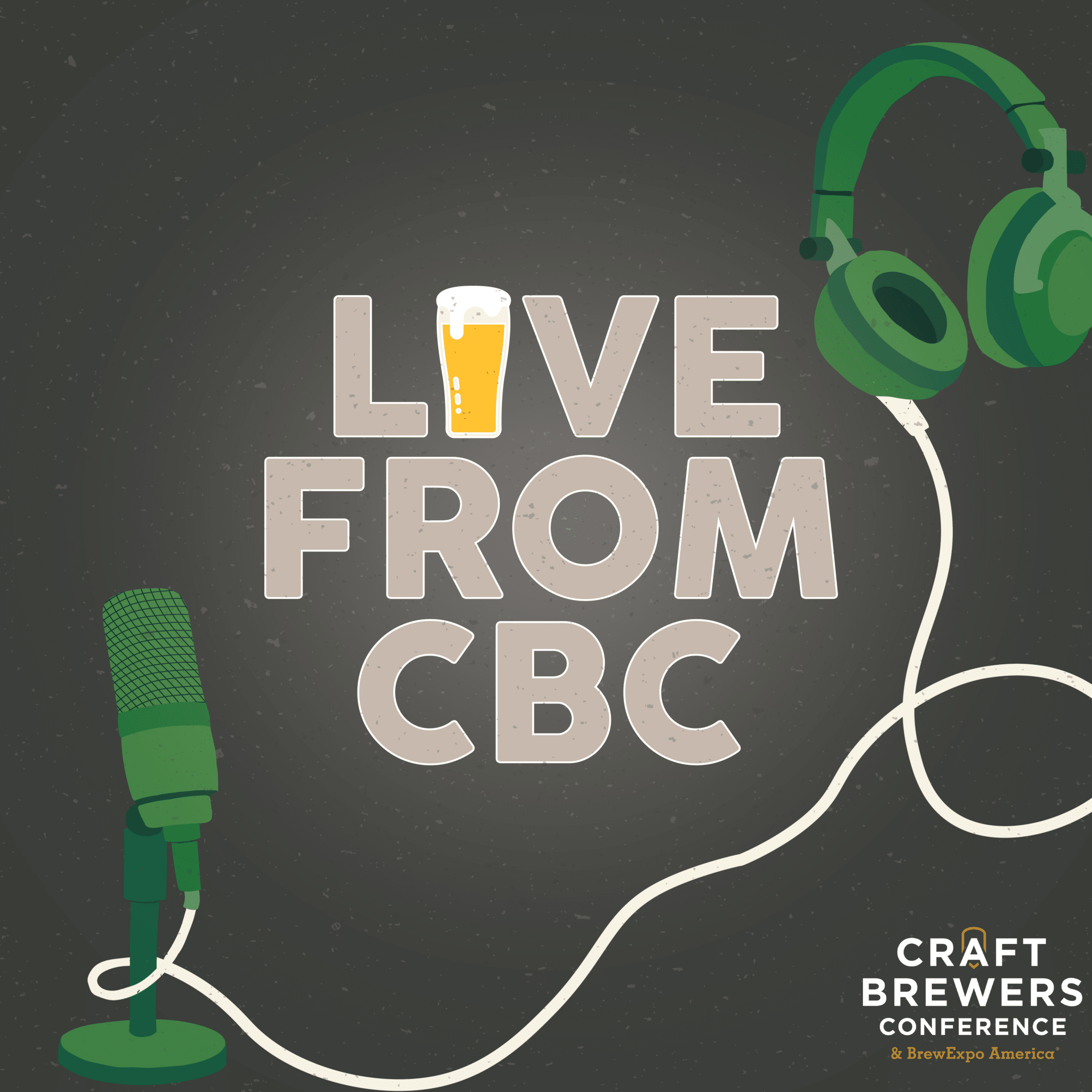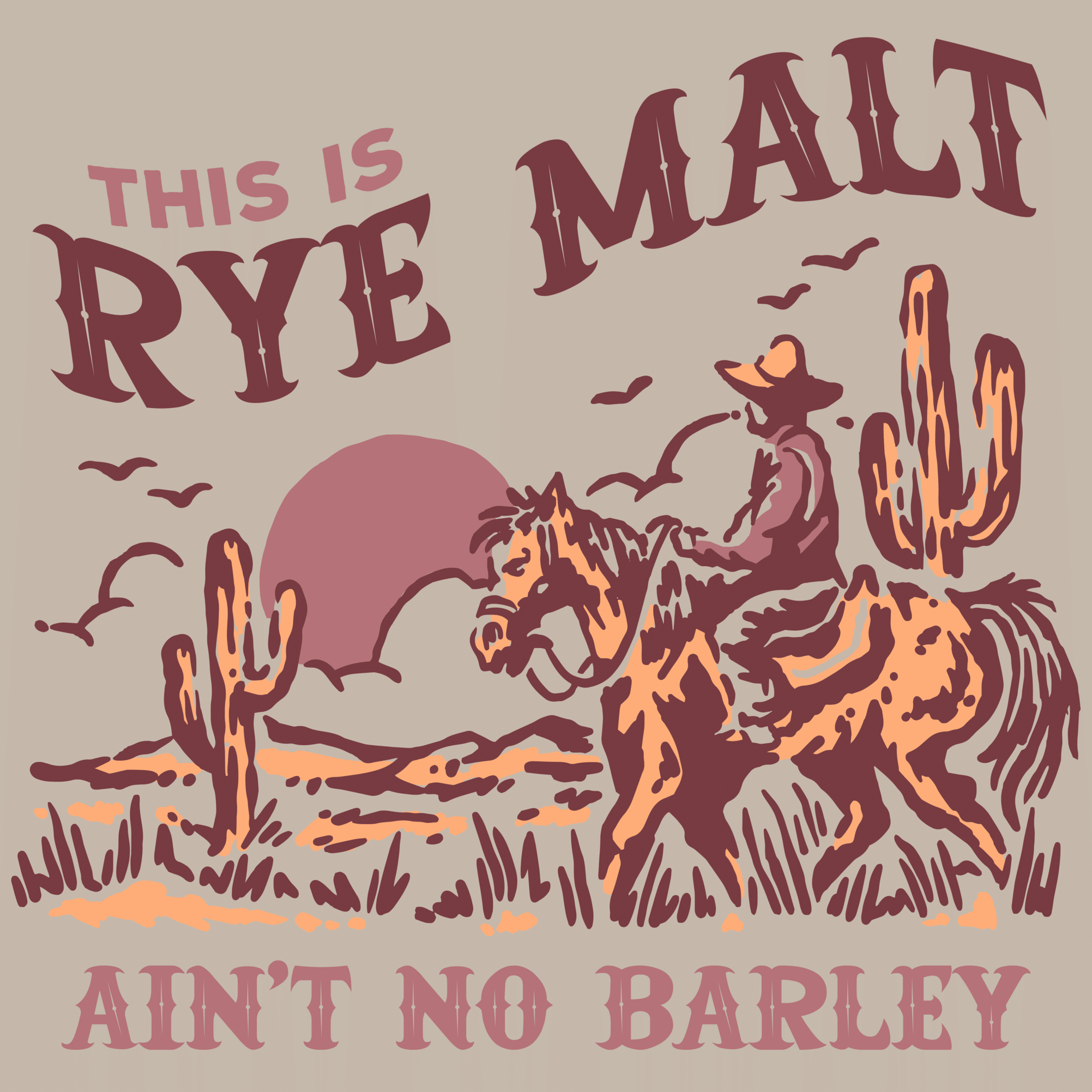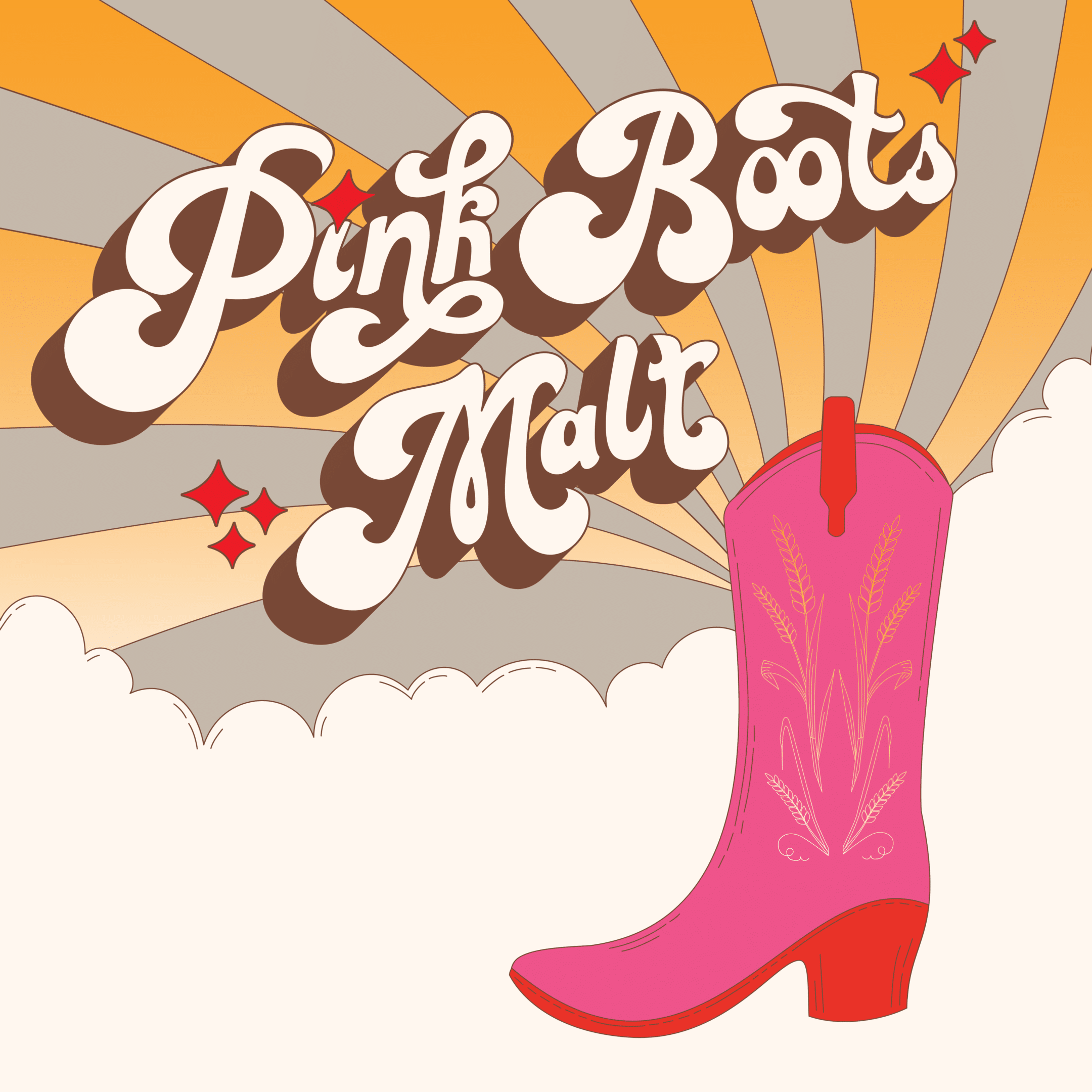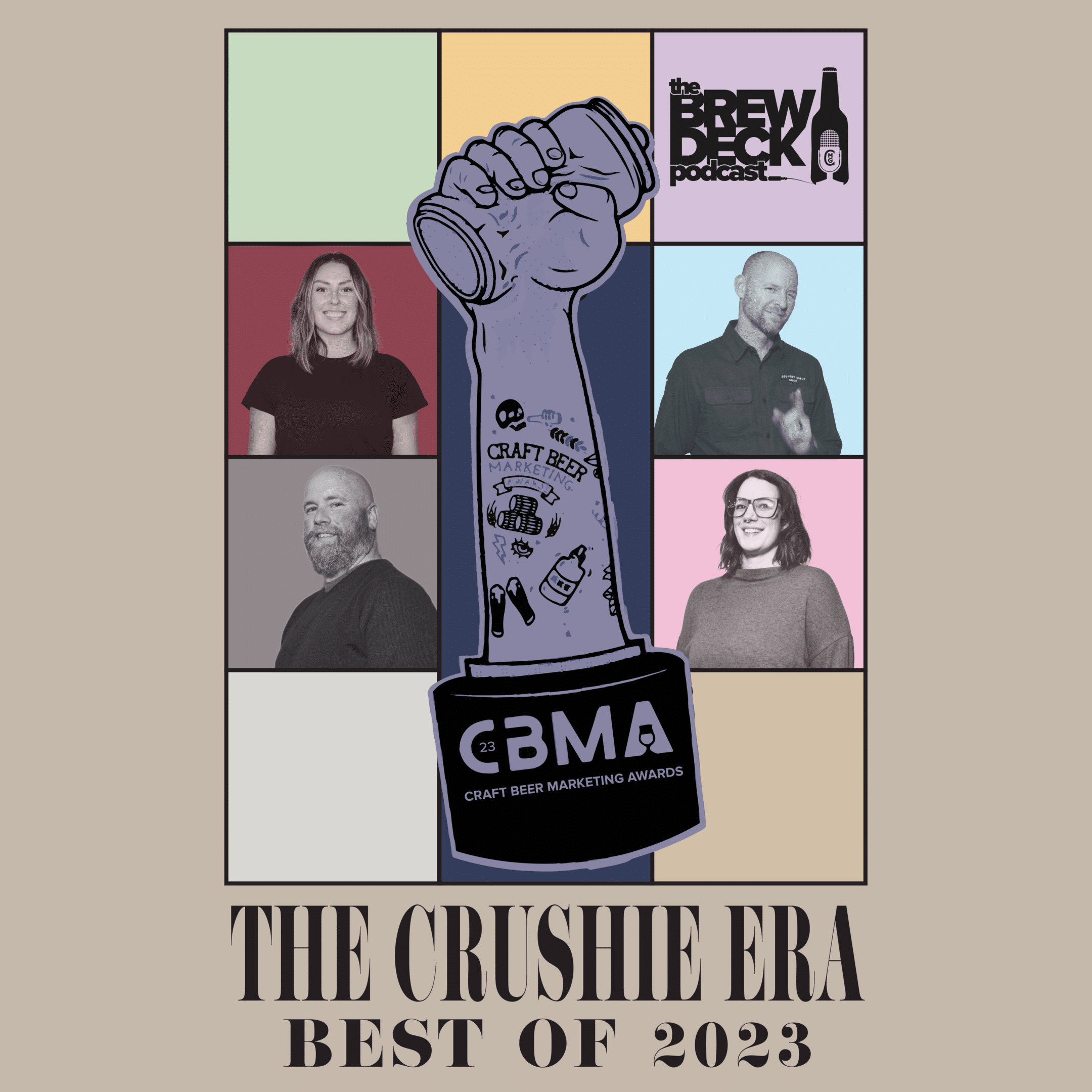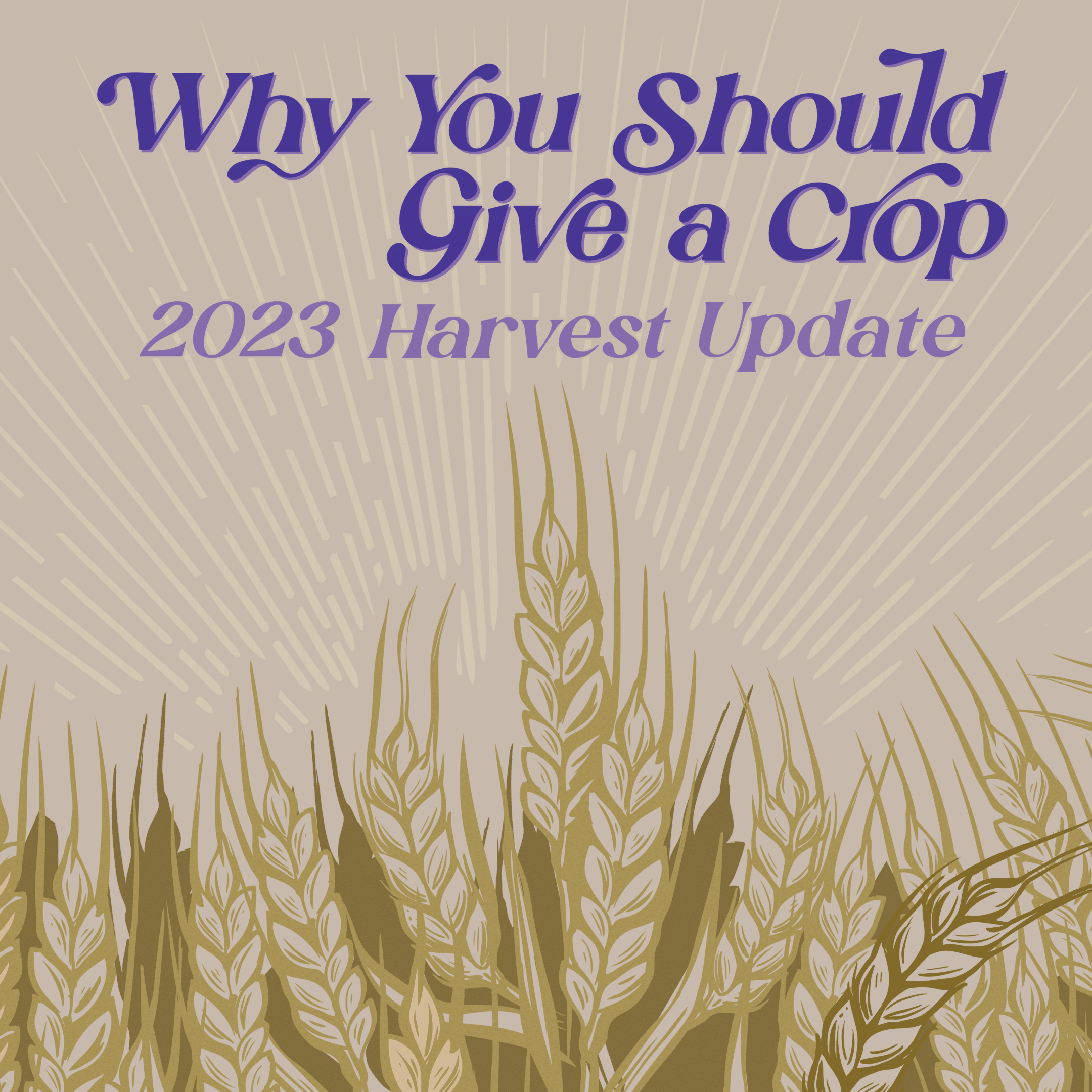
PODCAST GUEST
Graham With
 Graham With is the Head Brewer and Co-Founder of Parallel 49 Brewing in Vancouver, British Columbia. Parallel 49’s beers have won numerous awards Nationally and Internationally. He is a National-ranked BJCP judge and Co-Founder of the Vancouver Homebrewers Association.
Graham With is the Head Brewer and Co-Founder of Parallel 49 Brewing in Vancouver, British Columbia. Parallel 49’s beers have won numerous awards Nationally and Internationally. He is a National-ranked BJCP judge and Co-Founder of the Vancouver Homebrewers Association.
MORE EPISODES
SEASON 4, EPISODE 7: GOING FOR GOLD
PODCAST HOSTS:
HEATHER JERRED – TERRITORY MANAGER, COUNTRY MALT GROUP
CHEYENNE WEISHAAR – SALES REPRESENTATIVE, COUNTRY MALT GROUP
CJ PENZONE – TERRITORY MANAGER, COUNTRY MALT GROUP
GUEST:
GRAHAM WITH – HEADBREWER AND CO-FOUNDER, PARALLEL 49 BREWING
Key Points From This Episode:
- Tips for preparing beers for competition season
- Advice for choosing which competitions to enter
- Utilizing your judging sheets to improve future beers
- What judges are looking for
- How Graham got into judging
- How judging has influenced Graham’s decisions about entering his beers into competitions
Transcript - Going for Gold
EPISODE S.4, E.7
[GOING FOR GOLD]
Heather (00:08):
Welcome back to another episode of the BrewDeck Podcast. I am your host, Heather Jared, and I am joined again by CJ and Cheyenne. This week we’re going to be talking about competition season as it is upon us. We are going to be joined by nationally ranked BJCP Judge and Brewmaster at Parallel 49 Brewing in Vancouver, BC, Graham With. He’s going to tell us how he prepares for our award season and give some tips and tricks from the judging side.
CJ (00:32):
As we move into competition season, I wanted to remind you all of our Filson Vest Gold Medal Program. We know that with our malts, brewers and distillers across North America create incredible award-winning craft beverages. We award one Filson Vest to each brewery that wins gold using Great Western Malting or Canada Malting Co. products at the World Beer Cup, Canadian Brewing Awards, or the Great American Beer Festival. We also award it to any distillery that wins Double Gold Tier at the San Francisco World Spirits Competition.
Heather (01:03):
I am excited that we’re continuing on the Filson Vest program. It was such a hit last year, so really, really excited to see what people are making this year so we can get some more of those out there.
(01:14)
Cheyenne and CJ, you both were brewers in your past life. Any tips and advice for the brewers out there on how you prepared for competition seasons?
Cheyenne (01:26):
Yeah, definitely. I think that in our conversation with Graham, as the listeners will hear, he kind of touches on this, but something that we did quite a bit was we would do sensory analysis on all of the batches that we had canned and available to send the competition. You think that the freshest batch is always going to be the best batch, but that’s not necessarily true. So we would do blind sensory on all of the available cans that we had out of our batch library, and a lot of times, it would end up being not necessarily the freshest batch. And so we would do the sensory just to see which one best represented that style, which one best reflected the category that we were entering, and we would make our decisions that way.
Heather (02:07):
CJ, can you tell me some of the competitions that you entered beers into?
CJ (02:11):
Yeah, we would enter into the Great American Beer Festival, the World Beer Cup, and Pennsylvania has a fantastic farm show where they judge beers from all across the state. That was always a really fun one to enter.
Heather (02:23):
Awesome. Cheyenne, so what were some of the awards that you did win? I’d love to hear about it.
Cheyenne (02:29):
Our most award-winning beer was our kölsch, actually, which was one of my very favorite ones to brew and it’s actually one of my favorite styles too. So I really loved sending that one off.
(02:39)
We also had a session IPA that tended to do very well, and actually, Graham mentions this in our interview as well, but we had been entering our session IPA into an IPA category and it wasn’t winning much. And so we had gotten back some judges notes that had said, “Hey, this is a great beer, but it looks like it might be in a bad category for the style.” So we actually ended up changing the category that we were submitting and then we started seeing that beer win awards.
(03:04)
So definitely good to kind of taste the beer as is, not necessarily what you intend it to be, and then just see does this reflect the category that I want to enter it into?
Heather (03:15):
Yeah, that’s great advice. And I will say that kölsch is delicious. I did get to try it when we were done at CPC last year, and I really, really enjoyed it.
(03:23)
And CJ, can you tell us a little bit about your process going into competition season?
CJ (03:28):
Yeah, so competition season was fun for me. It was totally backwards of how I like to brew beer. I typically brewed beer to taste or just how I really wanted to express that style. So gearing up for competition season was a total change of gears for me.
(03:48)
I’d have fun with it by targeting lesser entered categories and I would just do a lot of research on the BJCP specs for that category, and I’d look at past winners, see if there’s any info out there on what kind of malts or hops or processes those past winners have used. And then I would go through a few trial batches until I was happy and we would enter just like that.
Heather (04:11):
Awesome. Well, thank you, Cheyenne and CJ, for sharing your insight into competition season. Let’s jump into talking to Graham.
(04:20)
And we are pleased to be joined now by Graham With, Head Brewer and Co-founder of Parallel 49 Brewing in Vancouver, BC. Welcome, Graham.
Graham (04:30):
Thanks for having me.
Heather (04:32):
Can you start off by telling us a little bit about yourself and a little bit about Parallel 49 and how you ended up there?
Graham (04:39):
Yeah. We have been around I think 11 years because I’m planning our 11th anniversary beer right now. We’re in East Vancouver. And I got my start, I’m a home brewer, so I took the jump from home brewing into professional brewing, and yeah, our brewery is a sizable one. We make a lot of hectoliters, or beer barrels as the Americans call them.
Heather (05:08):
Yeah, I was going to say you want to translate that for the American listeners?
Graham (05:11):
Yeah, it’s just a little less, but in beer barrels.
(05:15)
Yeah, we take our approach… I don’t know, we like to make beer sort of whatever Vancouver beer would taste like. We like the water we have here and I take a very big home brewer approach to all the stuff we make, so we kind of make whatever beers we feel like, that we want to drink, and it seems to have gone well for us.
Heather (05:34):
So did this all just start around you sitting around with some home brew friends and deciding one day, Hey, we should maybe do this professionally?
Graham (05:42):
I mean, almost. I knew a few guys who had a beer restaurant in East Vancouver and they always wanted to start a brew pub or brewery, but the regulations are a bit challenging. But after their restaurant did well, St. Augustine’s, which is a great place, they still wanted to take the plunge into brewing. So I met up with them. I brought a few growlers full of whatever was in my Kegerator home brew at the time. They loved it and we got along well and then so I joined up with them, and it was like 2011, and then we finally got beer out the door in May of 2012.
Heather (06:24):
Nice. What was the first beer you put on market? That’s just for me to know.
Graham (06:28):
Oh, well, we launched with four. We had a hoppy red ale, our Ruby Tears, and we had a… It was an India Pale Lagger as we called it, and a brown ale and a watermelon witbier because we launched for the summer. Those are the four first ones we did.
Heather (06:46):
So has that watermelon witbier ever come back?
Graham (06:52):
We put it on a tap in the tasting room, just like a smaller batch, recently and it was really good. But it’s fun to put it out there and then take it away and make people want to wait for it, right?
Heather (07:03):
Create demand.
Graham (07:04):
Yeah.
Heather (07:06):
Well, Parallel 49 is definitely not strangers to winning awards. Can you tell us about some of the ones that you’ve won? Because I actually had to pick some up for you, one of the last awards.
Graham (07:17):
Ah, yes. Yeah, we like to enter awards. We have a big list of all the things we’ve won. I don’t know. We enter, there’s BC Beer Awards for British Columbia. We’ve won, I don’t know, 20 or 25 or so over the years. I don’t know. I was trying to go through the list and mention stuff. It feels like you brag.
Heather (07:45):
You can brag. It’s what we brought you on for.
Graham (07:45):
Yeah, right?
Heather (07:45):
Brag it up.
Graham (07:45):
We have a craft lager we do, which is a pretty basic premium lager. That’s won like five gold medals, which is nice. We have a hoppy wheat beer called Jerkface 9000.
Heather (07:58):
I love that beer.
Graham (07:59):
It’s good beer.
Heather (08:00):
It’s a good beer.
Graham (08:02):
We’ll get into the styles and stuff, but it’s a little off-style because it’s like a hoppy American wheat. So it really depends on the judges, but sometimes they love it and we get awards with that one. But yeah, we’ve won a bunch of different categories over the years.
(08:18)
Awards are nice. Whenever you win an award, it’s great. And then whenever you don’t win awards, you’re kind of like, “Yeah, whatever. Who needs them anyways?”
Heather (08:27):
Well on that, do you get the judging sheets back and do you consider any of the notes that the judges gave when you don’t particularly get an award?
Graham (08:37):
I mean, we look at them. I don’t look at them too heavy. If they’re giving advice on our recipe like, “Hey, maybe you should make it a little lighter,” we don’t care. It’s more for if there’s anything oddball about it. If they’re like, “Hey, there’s a little DMS,” or if there’s a little something amiss with the beer process, then we’re kind of interested what they have to say. But as far as us designing the beers we do, we just make the beers we think we want to drink and our customers want to drink, so we don’t really want to change too much. We’re not going to change a best-selling beer in order to do better in competition. Yeah, right.
Heather (09:24):
Yeah. Just because it didn’t win gold, but it sells on the patio in the summer.
Graham (09:29):
Yeah. But if there’s any flaws or anything that’s a little off with it, we’re interested to know, and then we can go do a little digging on our end and see if we agree with it, and if there is, how to improve upon it.
Heather (09:42):
So how do you decide what competitions that you actually want to enter? You mentioned the BC Beer Awards and we’ve got the Canadian Beer Awards, World Beer Cup. Are you entering all of them? Are you being a bit more selective? We know it gets kind of expensive to ship beers off to these things.
Graham (09:56):
Yeah. I guess we pick our more regional one, which is the BC one. We do the national one, which is the Canadian Brewer Awards, and then there’s the World Beer Cup put on by the Brewers Association in the States. That seems like the big one.
(10:11)
There’s a bunch out there and then there’s more that have come in and it’s hard to vet to see which ones to enter. I know there’s a few more national ones in Canada that have kind of come up.
Heather (10:25):
Yeah, there’s been a few that have popped up recently.
Graham (10:26):
Yeah, and it’s a bit tough. I know there’s a sort of national guild in Canada for brewers and they just got one going, and you want to support that because the guild kind of represents all the breweries, but there’s entry fees and there’s organization, and whenever we have to go gather all these entries up, we go do some tasting and things. So there’s a bit of effort.
(10:53)
And there’s other ones too that maybe it seems like a bit of a, “Hey, pay us a bunch of money and enter some beers and you’re probably going to get awards,” and it seems like more like a marketing thing than a working with breweries to award who’s doing stuff. So we kind of vet them, but we try and do our best, but there’s no real rhyme or reason to which ones we pick.
(11:17)
But I guess in my personal philosophy, if it’s a little more nonprofit and kind of working with the craft brewers, I mean then the intention’s good, that’s kind of what I look for.
Heather (11:29):
Yeah. So how do you decide which beers you want to enter? Are you just kind of throwing them all out there or being a bit more selective with which ones you’re going to send off?
Graham (11:40):
Yeah, it’s always nice to win awards with your core beers that you sell because you can use that as marketing and a push. So we sell a lot of lager, of course. People drink lots of lager. So when you win a gold medal, hey, that’s great. Everyone’s like, “Well done, brewers.”
(12:00)
I mean, I’m sure smoked beers sell somewhere, but if you win a smoked, like a rauchbier category, you might not sell lots. So it’s always nice to try and enter your cores, but then also if you do have a nice rauchbier or an oddball style that you’re really proud of and you think is going to win, you can enter those as well. It just sort of depends.
(12:30)
But we like to enter core beers. Like in the World Beer Cup, we try and go more core brands because you get bigger recognition. The smaller the awards, the more we put in random things just because it’s more like you are going to meet up with everybody. Like at the BC Beer Awards, we know of all the breweries, you’re surrounded by friends. So you enter a bunch of weird oddball things. But the bigger the competition, the more I go towards core.
Heather (12:58):
Didn’t you win Brewery of the Year at the BC Beer Awards?
Graham (13:01):
Nope, nope, no. We won Best Beer.
Heather (13:04):
Best in Show.
Graham (13:05):
Best in Show, yes.
Heather (13:05):
Best in Show.
Graham (13:07):
That was cool. Yeah, we did a, was it a Brett Saison in a cork-and-cage fancy bottle we were very proud of. And it was our 10-year anniversary beer, so it was kind of nice for the 10-year to win Best in Show.
Cheyenne (13:24):
All right. So not only are you the Head Brewer at Parallel 49, but you’re also a nationally ranked BJCP Judge. Is that correct?
Graham (13:31):
That is correct.
Cheyenne (13:33):
Can you tell us a little bit about how you got into beer judging and the training that went into that?
Graham (13:39):
Yeah, so I guess back when I was starting to home brew, and I think a lot of people go through this sort of process where you make your first batch of home brew and you’re blown away that it tastes reasonably okay, but to you, it’s the best tasting beer ever because you made it yourself. So me and my roommates back in the day, we started home brewing and we were like, “Wow, this is good,” and then you get a beer book and you’re like, “I’m going to learn more.” And then the next batch, you learned a bit more so it starts to taste better and better.
(14:13)
So when you start going down the rabbit hole of buying more equipment for your home brewing and you’re buying all the beer books and trying to improve your process and not make any mistakes, inevitably you start coming across beer judging and home brew competitions.
(14:30)
So I think we started looking around, I think it was 2008 or ’09, how do we BJCP exam that you read on the internet to do? And at the time, I think there was two judges in British Columbia and they didn’t live in Vancouver, they lived in the middle of nowhere. So I had to get my friend Abe, who lived in Portland, and he was a national ranked judge. So you have to have a certain rank, and we can discuss how to get there, in order to have an exam and be able to administer the exam.
(15:09)
So we booked an exam in Vancouver. I think we wrote it in early, I think, February 2011, and we had 12 people write the exam. This is the legacy exam where you did a… It’s three hours long with judging six beers and you had an hour and a half written exam as well. Since then, they split the thing into two different exams. But it was an ungodly hard test. And I did an engineering degree and so did my partner Katie, and both of us agreed it was one of the hardest exams we’ve ever done.
(15:44)
But the studying is a lot more fun because you’re studying beers, you’re going out and there’s all the different style guidelines, which goes into all the different styles of beer, English bitters, bells and tripels. You go out, you purchase the classic examples of them, you start to understand what these guidelines that are telling you about the beer.
(16:07)
So we got the exam, we wrote it, it was brutally hard, but we got through it. And then we had 12 judges, I guess 14 in BC. And then after that, you get a certain rank based on how well you perform on the exam. So I think I started off as a, you get a recognized rank and then there’s a whole points program that comes into it, so the more you actually go out there and judge beer competitions, you get awarded points for participating, and the more points you get and how well you do in the exam, you can climb ranks.
(16:47)
So I went from recognized, and then I did a few beer competitions, and that was enough points because my grades were good enough to get to a certified rank. And throughout the years, I took the exam a couple more times, just the tasting, to get my tasting up to pass 80%. And then when I got that and the combination score with my written exam, it was overall above 80% and I had enough points to go national rank. And national ranks, you get invited to a lot more competitions across, I guess, your region, but it gets a bit nerdy and you can go higher than national rank into a master rank, but oh, you got to be good at exams and you got to really want to do it. And I don’t know if I could go that far.
Cheyenne (17:45):
I was going to say, do you think you’re going to go for it? Maybe not.
Heather (17:48):
I feel like just for bragging rights at least.
Graham (17:51):
Yeah. Yeah. I don’t know, it’s tough running a brewery and then in the spare time, you’re like, “Oh, let’s do more beer stuff.” Maybe. I did go out to… I had a really fun time judging this past year, the Prairie Beer Awards. They paid for my flights and hotel to come out and judge, and it was super fun and it kind of made me think, “Oh, maybe I should try and go up in rank.” But that was then, and then I got home and then it started to fade again. So we’ll see.
Heather (18:29):
So it was being in Winnipeg that really…
Graham (18:29):
You know, Winnipeg’s not that bad, but it’s more like you’re surrounded by like-minded people who all do it, and they put a lot of work in to get this certification to judge, and you’re hanging out with them. And I met a ton of cool people that I stay in touch with now by judging. So yeah, it kind of reminded me how fun it could be to do some of this judging because you kind of volunteer your time. But yeah, you get to meet a bunch of like-minded people.
Cheyenne (18:58):
That’s very cool. Safe to say that there’s a lot of studying and training that goes into it, for sure.
Graham (19:03):
Yeah, I guess to get into studying and training, so to do the exam now, and the BJCP is a nonprofit, which I love because the exam fees are pretty low. I think to write the exam for the tasting for your first time, I think it’s like $40 US, and then if you rewrite it, it’s like $20 US.
(19:26)
But yeah, so now to do it, they’ve broken into two parts. So until you get over 80% on your tasting exam, you can’t write the written, which takes a lot of pressure off. Now the exam, you would go study. You want to know the styles fairly well. And it’s really focused on the judging aspect. When you do the written, you have to really start knowing the different water profiles and classic regions for beer styles and really get into it. So you’ve got to study the different guidelines for styles, like an American IPA, what’s an English IPA, the classic trappist beers, and all that.
(20:09)
But then the biggest thing is doing, and this is what I recommend to people, is practicing to do these score sheets to make sure you have a comprehensive score sheet that goes over all the aspects of the beer that’s complete and well-written. And if you can do that in the tasting exam, which is six different beers, which may be great, or maybe there’s an issue, if you can completely fill out your score sheets of what they’re looking for, then you do pretty well. And then you get to get out there and start judging the competitions.
Cheyenne (20:44):
So I actually am a brewer by trade, and so I’ve always wondered this. You take so much care and packaging up your beer, you send it off. Can you tell us a little bit about what a day of beer judging is like?
Graham (20:58):
It sounds super fun, and then you get there, you’re like, “Actually this isn’t as fun as I thought.”
(21:07)
So yeah, depending on the competition too. I know my buddy Matt helps run the BC Beer Awards and he really grinds you to come judge every day, day after day for five-hour sessions. It can be a bit fatiguing. You’ll jump into, I guess, a category and you’re working with… So you’re always judging with someone next to you, if not two other people. And you’ll go through many different beers of the same style.
(21:39)
And then I guess when you finish up, there’s usually a Best of Show round, so like a dog show really. So all the best beers in the category kind of go forward. And then I guess it’s a mini Best of Show. So in, say, an American IPA category, you kind of go… Okay, there’s five beers that we all quite like, which one’s getting first, second, and third, and which two are out? And then once you go through all the categories, the first place in each category goes into the Best of Show round, which is more like the dog show when you have to compare a Rottweiler versus a Scottish Terrier and argue why the Scottish Terrier is cuter and his haircut’s nice. But yeah, it can be a long day.
Heather (22:32):
These analogies are amazing.
Graham (22:32):
I’ve always used the dog show analogy. I think it works pretty well. You know?
Heather (22:35):
For sure.
Graham (22:36):
Yeah, you got big muscley, giant beers, and then you got little tiny beers, but they’re all adorable.
Cheyenne (22:43):
So when I’ve received notes, you will sometimes see ones that have a check that says, “Advance to the medal round,” and so is that what you’re talking about? There’s an initial judging round and then those that are picked to go to the medal round, that’s kind of like the Best in Show?
Graham (22:57):
Yeah. So if you have a big category, which IPAs or whatever is the hot style that a lot of, say, brewers or home brewers would be making, you might get 48 different beers in the category. So you’ve got to basically chip away at them all until you’ve kind of got your top whatever grouping it’ll be. I find it usually ends up you can split it between different groups of judges, so it’s not just one group judging all 48. You can split it into, let’s see, math on the spot, three groups of 12? Nope, four groups of 12. And then everyone pushes their two or three best ones forward. And then you kind of go through and discuss and it’s like, “Okay. Well, which ones are we going to make the medal ones?”
(23:49)
So yeah, if you make it to that round, I would say, “Congrats, your beer is great.” If you get to the top ones, then you’ve got to decide, okay, let’s go pick these beers apart and decide which ones are the best. So if you’re getting upwards in the categories and making it to the mini Best of Shows, yeah, that’s awesome. You’re doing great.
(24:10)
There’s a whole scorer system as well. We’ll get some feedback on scores. We’ll see the score, but we didn’t get a medal. But if you’re doing in the high 30s or into the 40s, it’s like a 50-point system, you can be like, “Okay, well we did great. We didn’t get a medal, but the judges like it.”
Cheyenne (24:31):
It’s still a good beer.
Graham (24:33):
Yeah, exactly.
Cheyenne (24:34):
Well, very cool. Well, this is a very broad thing and I know that you probably judge a lot of different styles, a lot of different categories, but what are you looking at when you are judging? What is on the judging sheets that you’re looking at?
Graham (24:47):
Okay, for those who I guess don’t know what these look, there’s always a one-page sheet and there’s different sort of categories that are more objective.
(24:59)
So you have aroma, which is the first thing you get. So basically, when you get one of these beers in front of you, because beers are carbonated or typically carbonated, the aroma’s coming out with a carbonation so you want to judge that first because as the CO2 escapes, less aroma’s getting pushed out towards you. So the first thing you do is you write about the hops, malt and any fermentation esters in the aroma and if you see anything kind of off or there’s anything weird about it. That’s scored out of 12 points.
(25:36)
And then the next one is appearance. So you’re always going to get a little cup that’s see-through and then you can do the appearance and you’re looking at is it clear? Is it hazy? If it’s supposed to be hazy, what is the head retention like? What do the bubbles look like? And does it look like it’s supposed to? If you have a lager, is it clearer and have a nice white head on it? That’s out of three. That one’s usually a give-me where, if the beer looks like it’s supposed to, it’s three points. I usually just give it three points because you kind of ding it on aroma and flavor a little more.
(26:20)
So those are the first two, so you’re at, I guess, 15 points.
(26:24)
The next one is flavor, which is the big one because that’s why we’re drinking beer because it tastes good. That’s out of 20 points. So it’s similar to the aroma. You’re going through all the flavors in the beer, you’re commenting on the malt, the hops, any any adjunct stuff too because there’s fruit beers or spiced beers. Are you picking up, if it’s a cherry beer, are you picking up these fruit notes? And then also, you’re commenting, is there anything kind of off with the beer and marking that. And that’s out of 20.
(26:57)
And then you go to mouth feel. So you’re looking at is the beer creamy? Like in an oatmeal stout, the oats provide a creaminess. What’s the carbonation level? Is it super rip-roaring high? Is it low? I guess you can be a little astringent if it’s a super sour beer or if it’s maybe over-lautered and sparged, it might get some puckering. That’s out of five. So I guess you’re at 40 points there.
(27:28)
And then the last is the overall impression of the beer, which is when you can kind of get more subjective. So you can comment on all those first four categories and then you break down to, “Hey, this is a great beer, I enjoy drinking this one, you seem to have hit everything. It’s a well-crafted beer. The process seems good. I thought maybe it was a little…” I don’t want to say too hoppy. Let’s say not hoppy enough. “Your beer is not hoppy. I think it would do better if you just bumped up the hops a bit.” Or you might say, “It just tastes like maybe this was packaged four or five months ago, so it’s just not as fresh as it could be.”
(28:11)
And you can provide that bit of feedback on how your brain came to the scores that it did and you can reference stuff that came up. So if there’s any issues in the beer, like there’s some diacetyl, or you perceive maybe some lactic acid. You could comment on why you’re dinging the beers in those categories with flavor or aroma.
(28:38)
And more so on the home brewing end is when you’d offer advice on how to improve. So if you had a sour thing going on, you talk about cleaning and sanitation. If you had maybe some weird esters, you talk about how they’re pitching their yeast and their fermentation profile.
(28:58)
Usually on the pro-brewer end, I don’t really comment on any of that because they should know what they’re doing and it’s not my job to tell them what to do. Usually on the pro-brewer end, it’s more, “Yeah, unfortunately there was some issue. So that’s where we got to there, but great job. Hey, the beer looked really good. So three points there,” and then you can comment on more on the recipe aspect of things. And like, “Hey, if it wasn’t this little sour thing, I think the beer would’ve been great, so focus on fixing that.”
(29:35)
But yeah, that’s kind of how the score sheets work.
Cheyenne (29:41):
Got it.
Graham (29:42):
And there’s little check boxes as well. So if you do taste something, like it’s just really boozy or you get the light struck kind of skunkiness, there’s little boxes you can check off. And at the bottom too, there’s a guide of is the beer outstanding, excellent, very good, fair, problematic? And you can kind of go…
(30:04)
One of my favorite boxes is the intangible one because sometimes a beer, it hits all the marks, but you just don’t know why I just don’t really like the beer. And that’s a great box to check. You’re like, “Yeah, great job. Everything seemed okay. It’s just, I don’t know why I just… Yeah, it’s good.”
Cheyenne (30:26):
It’s just not it.
Graham (30:28):
Yeah. Like I said, I did engineering. I didn’t do an English major, so it’s hard to put my thoughts into words sometimes.
Cheyenne (30:35):
I got my competition notes back once on a beer that I had submitted and it did very well and it medaled and the overall impression notes just said, “Very crushable,” and I thought that was very funny.
Graham (30:46):
Yeah, yeah. It’s hard when they’re all really good ones too because you’ve got to tell someone, “Yeah, I know this is an amazingly good beer, but someone beat you. And you didn’t get a perfect score, so why didn’t you get a perfect one?”
Cheyenne (31:00):
For sure. Well, very cool. And that leads into the next question. Do you have any advice for brewers as they prepare for competition season?
Graham (31:09):
Yeah. Well, the one thing I recommend is one, try and do the BJCP course or even just look into it a bit.
(31:18)
But the biggest thing is all these categories like Irish stout and whatnot, they’re all guidelines. So if you have a beer… A really good example of this is I finally won a World Beer Cup, which is like, “Oh God, it took me 10 years, but that was awesome,” with our pale ale. But I did not enter it in the American pale ale category because I thought it would get destroyed by all the delicious hoppy American pale ales. So I entered it in an English ale category because the judges aren’t going to know what’s on the label. They don’t know anything about this beer. They just know that there’s a liquid in front of them that someone’s calling, say, a stout or whatever, and they’re going to judge it that way.
(32:09)
So if you have a good selling beer and you make it and you’re proud of it, and maybe you call it an IPA but it’s like, I don’t know, 4% and hoppy, maybe that’s an American pale category. So be really weary about the categories you enter because you can get your butt handed to you.
(32:33)
And also, I know a lot of breweries, they have a marketing person and they kind of pawn off the entries on marketing because it’s a bit of a marketing thing. But if you’re marketing people don’t know too much about the judging aspect of things, they’re just going to look at what the style says on the product and they’re just going to enter it in the closest thing, but that’s not always the best route. The best route is to really take a look at the guidelines of the competition because your competition’s going to have their own set of guidelines and what best represents the liquid you make. Maybe your American amber ale is better as an Irish red or whatever. And there’s no shame in entering it in one that’s going to do better in my mind.
Cheyenne (33:20):
Basically, just kind of sticking what style category most closely resembles what we’re submitting.
Graham (33:26):
Yeah. And another thing too, as we’ve just entered a couple competitions, my team and I, we’ll go open up the last three or four pack runs we’ve done because we have a library stock of every run we package. And it’s not always the freshest one either. I’d love to say every beer we make here is the best beer ever and it’s always on point, but there is a threshold to be like, “Yeah, it’s good. I’ve had better batches of it.” And we’ve seen the one that was packed two months ago versus the one from last week, it’s just super good still, so let’s enter that one.
(34:08)
And it’s worth taking the time to do so, I think, just to make sure. You get the natural variances between batches inevitably so take the time to go grab the last few runs and see which ones are best.
(34:24)
I’ve heard of people entering, which I don’t do this, but I’ve heard of breweries, they just brew a special batch where, “Oh, we’re going to throw the hops up a little bit. Maybe use the super premium malt for the one special batch.” Which yeah, God bless them, but yeah, we don’t do that. But I think you could do well with it. I’m sure-
Cheyenne (34:51):
The way you giggled makes me think that you do it.
Graham (34:55):
No, no, I haven’t done it. Yeah, I just say take the time to go try a few batches, if you’re packing it regularly, to see which one’s the best and then make sure you’re entering the right categories.
Cheyenne (35:05):
Yeah, for sure. And what are your favorite style categories to judge?
Graham (35:10):
Yeah, I guess there’s two sides of it. One is like, what do I like to judge? And then there’s also the, what’s better for me as a judge to try and actually get better at?
(35:22)
So I like IPAs, I like hobby beers, so that category is a pretty good one for me with my knowledge to go tell which ones, in my mind, are better. There’s some subjectiveness too and process-wise. So if it’s stuff I’m super familiar with, that’s nice and easy for me, but also there’s certain categories that I just don’t have that much experience with. Recently, I was judging. I guess I proctored the exam in Calgary and the guy I was judging with really liked this wee heavy, and I really liked, I think it was an IPA, and we were kind of fighting about it a bit. But I just don’t know too much about wee heavy as a style. I’m not going down the streets to the local breweries and drinking wee heavies, so you can see it’s a little bit of a shortfall in my style vocabulary.
(36:19)
So maybe sometimes it’s nice to jump on those categories that you’re not too familiar with to get a better understanding on certain styles because not all, especially on the professional level, most breweries are just making beer that they think is going to sell reasonably well because they’re all operating a business. Whereas on the home brew end, which is super fun because people, they’re just making oddball beers. I remember I used to do it when I didn’t know what, say, a wee heavy tasted like because I couldn’t buy one or if I did buy one, it would be a year-old. So you can go make it and have a better understanding.
(36:54)
So I guess the cop-out answer is, yeah, throw me in any category. But there’s a reasoning behind it. So sometimes you’re just better at certain ones because you have them regularly and you know them intimately, and sometimes you just want to self-improve your skills as a judge and go on the ones you don’t know as much.
Cheyenne (37:12):
And do you get to choose the categories when you’re judging or are you assigned categories?
Graham (37:19):
Certain competitions, this depends on how the competitions are run. They’ll be like, “Hey, anything you don’t want to enter or don’t want to judge, just let us know.” There could be preferences. I usually just say whatever.
(37:33)
There’s a funny way home brewers do it because if you enter a style, you can’t judge that one because you might judge your own beer. But there’s a thing people will do when they really don’t want to judge, say, the urban spice category because everyone likes to, I guess, dis the urban spice category because there can be some crazy beers in that category. So they’ll just enter, oh, whatever. Even if there’s like a pale ale, they’ll just enter it in there and call it urban spice beer just so they aren’t allowed to judge that category, just to get them out of it.
Heather (38:06):
To get them disqualified for that category.
Graham (38:11):
Yeah, even if it’s the wrong style or whatever, it only costs $10 bucks an entry, screw it. I’ll just pay the $10 and I don’t have to do that one.
Cheyenne (38:21):
That fool that has to judge the urban spice category must be very confused.
Graham (38:25):
Yeah. I’ve had a few of those where you’re like, “I don’t understand what this is or why it’s here, but I’ll give it a three out of three for appearance.”
Cheyenne (38:34):
Oh, well I have one last question for you. So how has judging competitions influenced how you make decisions about entering your own beers into competitions?
Graham (38:48):
Okay, that’s a good question.
Heather (38:51):
Yeah, that one wasn’t on the list. We added that one later.
Graham (38:56):
Yeah, I got my cheat notes here, and now I can’t cheat.
(39:00)
How’s it judging? Yeah, I mean, there’s different ways judges judge, and some are pretty strict and they really nail it on your stuff. It doesn’t really… I guess it affects the entry we do as opposed to anything we’re making. When we’re, I mentioned my team and I, we’re sitting down, we’re trying the last three packs of this packaging runs of a certain style, we might all have, say, my favorite one and the team, we’ll all consensus that it’s like, “No, the second to oldest one is the one we like,” but we know maybe it was a little hazier, and we don’t really care, but we think the judges might tear it apart on that one.
(39:54)
Or if it’s like the scales are just… It’s between one and two and we think it’s this and, “Well, what do you think the judges are going to do?” And they’re going to attack it on a certain aspect on, say, the number one, so let’s put in number two.
(40:07)
So when it gets down to the decision-making between which ones you’re going to put in, it might end up at the very end, it’ll be like, “Oh, okay. Well, I think the judges might, they want to find something to fault it on, so they’ll probably fault that one. So let’s enter the other one.” I guess that’s how it works, but it doesn’t really affect how we’re making the bear too much. It’s more on the selection portion of it.
Cheyenne (40:34):
Very cool.
Heather (40:37):
Anything cool coming up from P 49 that we should know about that all the people should know about? Can you talk about your lager box?
Graham (40:45):
Lager box? So the pilsner pack?
Heather (40:47):
The pilsner pack.
Graham (40:50):
Yeah. It’s a very brewer pack, I find because all the brewers like pilsners. Yeah. We made a mix pack. It’s called Pilsner Around the World. And it features, and we took some liberties, but a French pilsner, an Italian Pilsner, an Australian pilsner, and an American pre-prohibition pilsner all in one pack. So we were pretty excited about it. And we’ve been known to go drink some of them after work in our tap room.
Heather (41:23):
One or two.
Graham (41:23):
Yeah. So that one, we’re pretty proud of and we’ll see how it does. We made a lot of it. I think they’ll sell well. I don’t know. It’s always hard to guess what the people want, so that’s cool, putting it out there. Our own internal stuff, I’m excited because we got a new brewhouse that showed up last week?
Heather (41:44):
It was last week, yeah.
Graham (41:46):
Yeah, it’s a 100 hectoliters, or for you Americans, 85-beer barrels. And it’s all automated, so we’re pretty pumped because like I mentioned, you get all these variances between batches depending on what the brew gods want. But with this little more automation on this system, I think we’ll get these variances down a bit more. So the nerdy side of me is excited for that.
(42:15)
But yeah, I guess also, we have a big beer garden and the city finally said, “Okay, you can have your beer garden back this year.” So that’s like April 1st we might open, but we’re in Vancouver, so who knows if it’s going to be raining. I don’t know.
Heather (42:28):
I don’t know. I’m in Calgary right now and it was like plus five this weekend and people were sitting on patios and I’m like, “It was like plus 15 in Vancouver and people still aren’t sitting on patios,” so there’s a difference in the temperature. But it’s a great patio. I like your beer garden, so I’m excited.
Graham (42:45):
Yeah, hopefully that opens soon.
Heather (42:48):
Awesome.
Graham (42:48):
People are itching for it.
Heather (42:51):
Well, thank you so much for joining us today, Graham, and letting us see both sides of the judging table on this one.
Graham (42:58):
Yeah, thanks for inviting me on. It was a pleasure.
Heather (43:01):
A great big thank you to Graham for joining us today. And as we’re on the topic of competition season, we wanted to just chat shortly about the BestBrewChallenge. So if you brew a Dark Doppelbock with BESTMALZ Black eXtra Roasted Malt between April 20th and April 23rd, ship it to BESTMALZ in Germany by July 5th, you have the chance to win a free trip for two to Brau in 2023 in Nuremberg. More information is up on our blog or just reach out to one of your sales reps.
Cheyenne (43:31):
We are also gearing up for Nashville coming up here soon.
Heather (43:35):
Woo!
Cheyenne (43:35):
We’ll be at CBC. We’re all very excited. If you want to learn more, you can visit countrymalt.com/cbc23 to get a preview of our booth, the beers that we’ll have on tap and much more. And it’s coming up fast in 34 days.
CJ (43:48):
And we’ll be back in two weeks for our special Earth Day episode. In honor of Earth Month, we’ll be celebrating sustainability on our blog and social media. Follow Country Malt on Facebook and Instagram to stay in the loop.
Heather (44:01):
Awesome. Thanks everyone.

